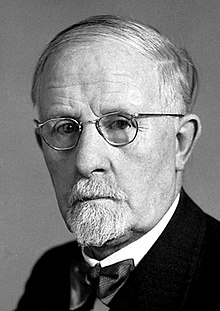Walter Rudolf Hess
Walter Rudolf Hess (born March 17, 1881 in Frauenfeld / Canton Thurgau ; † August 12, 1973 in Muralto / Canton Ticino ) was a Swiss physiologist and Nobel Prize winner in medicine .
Life
Hess was the son of Clemens Hess and studied medicine in Lausanne, Bern, Berlin, Kiel and Zurich. For a few years Hess worked as an ophthalmologist before turning to physiology. From 1912 until his retirement in 1951 he worked at the Physiological Institute of the University of Zurich , interrupted by a one-year research stay with Max Verworn in Bonn. In 1917 he was elected full professor and director of the institute; since 1925 he was also a member of the Leopoldina . His research began as a student and initially focused on the regulation of blood circulation and breathing before he began his epoch-making subcortical stimulus experiments, which won him the Nobel Prize in Physiology or Medicine in 1949 for the discovery of the diencephalon as the center of the autonomic nervous system . He also dealt scientifically with the organization of motor skills, as a result of which he developed modern concepts about extra pyramidal motor skills . Up until old age he also dealt with the interaction between the vegetative nervous system and the psyche.
In his experiments, he was able to use electrodes in the brain to trigger emotions in cats such as anger. Erich von Holst later pursued similar experiments with chickens and José Manuel Rodriguez Delgado (Yale University) with monkeys and humans.
In 1949 he and António Caetano de Abreu Freire Egas Moniz jointly received the Nobel Prize for Physiology or Medicine: Hess for “discovering the functional organization of the diencephalon for coordinating the activity of internal organs”, and Moniz “for discovering the therapeutic value of the prefrontal Leukotomy in certain psychoses ».
Fonts
- Contributions to the physiology of the brain stem. I. part. The methodology of localized irritation and elimination of subcortical sections of the brain . Leipzig: G. Thieme 1932.
- The diencephalon and the regulation of circulation and breathing . Leipzig: G. Thieme, 1932.
- Contributions to the physiology of the brain stem. Part II. The diencephalon and the regulation of circulation and breathing . Leipzig: G. Thieme 1938.
- The functional organization of the autonomic nervous system . Basel: B. Schwabe, 1948.
- The diencephalon. Syndromes, locations, functions . Basel: B. Schwabe, 1949; 2nd expanded edition 1954; English edition: The Diencephalon . New York: Grune & Stratton 1954
- Hypothalamus and thalamus. Experimental documents . Stuttgart: G. Thieme, 1956.
- Psychology from a biological point of view . Stuttgart: G. Thieme, 1968.
literature
- Martina Keilbart: Hess, Walter Rudolf. In: Werner E. Gerabek , Bernhard D. Haage, Gundolf Keil , Wolfgang Wegner (eds.): Enzyklopädie Medizingeschichte. Walter de Gruyter, Berlin and New York 2005, ISBN 3-11-015714-4 , p. 586.
- Anton Valavanis, Alexander Borbély: Walter Rudolf Hess - Leben und Werk, On the occasion of the 70th anniversary of the award of the Nobel Prize , Ed .: Clinical Neurocenter, University Hospital Zurich 2019 Online PDF
Web links
- Literature by and about Walter Rudolf Hess in the catalog of the German National Library
- Huldrych MF Koelbing : Hess, Walter Rudolf. In: Historical Lexicon of Switzerland .
- Information from the Nobel Foundation on the award ceremony in 1949 to Walter Rudolf Hess (English) and a banquet speech (German)
Individual evidence
- ^ Thurgauer Jahrbuch: Nekrolog für Walter Rudolf Hess. Retrieved March 25, 2020 .
- ↑ Wut auf Kommando, Der Spiegel, No. 29, 1965, July 14, 1965
| personal data | |
|---|---|
| SURNAME | Hess, Walter Rudolf |
| BRIEF DESCRIPTION | Swiss physiologist |
| DATE OF BIRTH | March 17, 1881 |
| PLACE OF BIRTH | Frauenfeld |
| DATE OF DEATH | August 12, 1973 |
| Place of death | Muralto |
